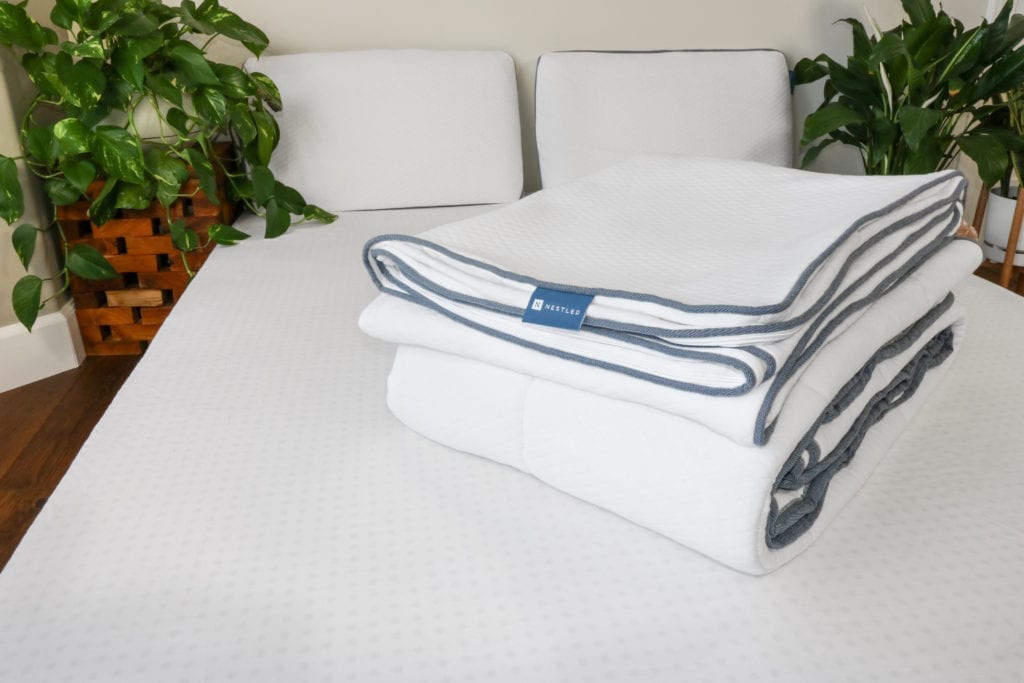
You might be shopping for a mattress topper, or maybe you’ve just purchased one for your home. What is the best way to set up your bedding to include a topper? Should it go on top of a fitted sheet, or under it?
In this post, Naturally Nestled offers recommendations on where to place your mattress topper among the variety of bedding layers available today.
How to Set Up Your Bedding With a Mattress Topper
Adding a mattress topper to your bed is a simple process that requires just a bit of planning ahead. This process also depends on the other types of bedding you have, such as a mattress cover or mattress pad (or both).
Here’s a rundown of how to arrange your bedding to include a mattress topper, and in what order you should place them, from bottom to top:
Mattress Topper
Whatever style of mattress topper you choose, from latex to wool to gel memory foam, you can place your topper directly onto a mattress before adding a mattress protector or fitted sheet. Adding a cover to your topper can protect it from dust and dirt, which can help it last longer.
Mattress Pad (optional)
Some people can’t get enough soft layers on their beds. Made for comfort rather than support, mattress pads are great for adding a little extra softness, like laying a comforter on top of a mattress. Mattress pads come in different styles, including those made like fitted sheets to wrap around the top of a mattress. Other styles include pads with straps at the corners that wrap around a mattress or a flat pad that simply rests on top of a mattress like a mattress protector.
Mattress Protector
Mattress protectors are also typically designed like fitted sheets wrap around the corners and sides of a mattress. Mattress protectors can extend the life of your mattress by shielding it from spills, dust, and other particles. Look for a mattress protector that meets your specific needs, such as spill or allergy prevention. Some mattress protectors serve multiple purposes, like providing a barrier against sweat, dust mites, and pet dander. Look for a protector that combines breathability with protection.
Fitted Sheet
Once you’ve layered on your topper and mattress protector, it’s time to add your favorite fitted sheets. Because a topper can add anywhere from one to as many as six inches or more of height to your bed, look for fitted sheets with deeper pockets. Measure the height of your mattress plus a topper to determine the depth of fitted sheet you will need.
To keep your fitted sheet securely on your mattress, add some bed sheet fasteners. These elastic straps with clips that attach at the corners of a fitted sheet are sometimes also called bed sheet clips or bed sheet suspenders, due to their resemblance to the clothing accessory.
These fasteners are great if you toss and turn, have an adjustable bed, or if adding a thicker topper makes your sheets tend to slip off at the corners. You can also use bed sheet fasteners to convert a flat sheet into a fitted sheet.
Flat Sheet
Depending on who you ask, flat sheets are either optional or necessary. These responses tend to be regional. In the U.S., people typically use flat sheets between their blankets and fitted sheets. In fact, many sheets are sold as sets that include a fitted sheet, top sheet, and pillowcases. The European style uses only a fitted sheet and a blanket. There’s no right or wrong way to go here; it’s all personal preference.
Top Blanket
Last but certainly not least, add a blanket (or blankets) to sleep under. The choices here are varied, including quilts, duvets, and comforters–or some combination of them, depending on how warm you prefer to sleep. Weighted blankets are also growing in popularity; look for machine washable versions for easier care.
It’s possible to customize your own unique “lasagna layers” of bedding to suit your sleeping style and budget. The main thing to remember is to place your mattress topper under a fitted sheet, so it can function as an extension of your mattress.

